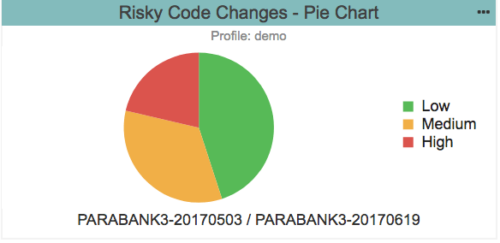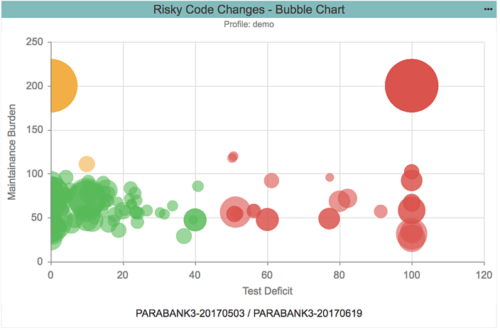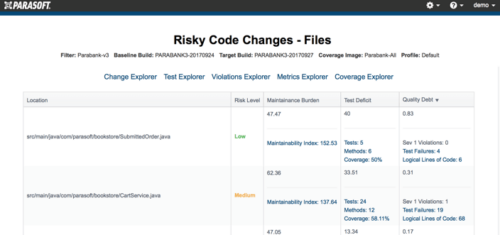Take a faster, smarter path to AI-driven C/C++ test automation. Discover how >>
Risk and Quality Debt: What You Don’t Know Can Hurt You
Many unknowns in the development equation are eliminated by knowing where the risk is and how each code change affects your system's security. Therefore, quality and security debt may be overcome with the appropriate emphasis. Learn how to prioritize and effectively reduce the risk associated with code modifications.
Jump to Section

Many unknowns in the development equation are eliminated by knowing where the risk is and how each code change affects your system's security. Therefore, quality and security debt may be overcome with the appropriate emphasis. Learn how to prioritize and effectively reduce the risk associated with code modifications.
When it comes to assessing the risk of a code base, it’s not a single bullet magic number a simple go/no-go traffic light. Risk is multi-dimensional and multi-variant. It’s measured differently for different organizations.
You probably already know where the high-risk or bad parts of the code are. They’re the parts of the code always changing—little tweaks here and there to fix little issues that seem innocuous in themselves but typically represent the layering of features on top of poor design. This is why making changes to existing code is the leading cause of introducing defects into an application.
But we also know that change is constant. You never implement everything completely or correctly the first time. Additionally, as developers layer on top of the existing code, knowledge of each use case and scenario gets lost, complexity increases, and the code becomes more and more risky. It’s these changes that provide the key to applying context to risk.
Just as important as the visibility into risk itself is understanding how to deal with it. How to prioritize remediation actions to achieve an acceptable level of risk while minimizing the impact on team velocity. This post looks at just that: how to assess the risk of code changes and how to efficiently prioritize and mitigate the risk.
Quality debt, or technical debt, in software development, can impose significant hidden costs on a project. While the immediate impact of taking shortcuts or compromising code quality may seem minimal, the long-term consequences can be substantial. Here are some of the hidden costs associated with quality debt.
When you have a code base that is poorly designed, lacks proper documentation, or violates best practices, it becomes difficult to maintain over time. Developers spend more effort understanding and navigating the codebase, leading to decreased productivity and increased maintenance costs on software products.
The longer quality debt remains unaddressed, the more products or services are prone to defects, glitches, and failures, requiring additional support and maintenance efforts. This not only strains the resources of customer support teams but also demands a significant allocation of time and money to fix issues. These ongoing costs erode profitability and divert resources away from other critical business initiatives.
The repeated need to fix issues caused by technical debt can lead to frustration, reduced productivity, and burnout among team members. Imagine subjecting a team of developers to debug or apply fixes on a product repeatedly. If it’s not a security breach today, it’s total glitches in uptime, and the list goes on. Having developers in this kind of loop can trigger a mass exodus from an organization, affecting workforce stability and expertise.
Low-quality code is more prone to bugs and defects. When shortcuts are taken or thorough testing is skipped, errors can go undetected and accumulate over time. Identifying and fixing these backlogs of technical debts becomes progressively difficult, resulting in increased debugging time.
The cost of addressing these bugs and defects in the future can far exceed the initial time saved by taking shortcuts. In addition, bug and defect accumulation also results in delayed delivery of products and affects the agility of the team. This is usually the case when the codebase has been made more complex with easy tweaks here and there.
Quality debt can impact the end user experience negatively. Users may encounter more frequent bugs, experience slower performance, or face usability issues. This can result in customer dissatisfaction, negative reviews, and potential loss of business. In addition to affecting customer satisfaction, accumulated quality debt limits the software’s ability to adapt and evolve.
Adding new features or integrating with other systems becomes challenging, hindering innovation and scalability. When companies have quality debt issues, it may also discourage developers from suggesting improvements or introducing innovative ideas, as they’re burdened with existing issues.
In certain industries, quality debt can result in noncompliance with regulatory standards, leading to legal consequences and potential financial penalties. Failure to meet quality and safety regulations can harm the brand’s reputation and erode customer trust, further exacerbating the hidden costs.
Risk isn’t a single number or a project-level traffic light. But, as shown in the pie chart below, Parasoft does use easily associated traffic light colors in the UI as a categorization of the codebase and guidance on where real and potential problems exist.

An example of a pie chart from Parasoft’s Process Intelligence Engine that shows the proportion of high, medium, and low-risk code.
The categorization of risk is both multi-dimensional and multi-variant, bringing together quality metrics from software testing techniques like static analysis and code coverage. No single technique provides the value for a specific dimension but rather provides a value for a formula. For example, code coverage isn’t a good number to use on its own because you could have 100% coverage but only a small number of tests doing anything meaningful. Instead, think about what you’re using code coverage to tell you, such as asking, how well is my code tested? Then, augment that with more data to get a more meaningful analysis.

An example of a risky code change bubble chart illustrating where the highest risks lie. Users can expand the bubbles to show the metrics driving the categorizations.
The bubble chart above illustrates the categorization of risk based on two dimensions. This is also shown in the screenshot below.
Code that has been poorly tested has a higher test deficit and is categorized as high risk (red). Code that’s well-tested and well-constructed has a lower maintenance burden and is categorized as low risk (green).
During the heat of development, your codebase is in a constant state of flux and every single line of code change presents an unknown risk. Will it break a fundamental feature? Does it introduce a security flaw? The less information, the greater the risk. Code coverage needs to be used intelligently to predict where to focus testing resources. However, even with increased coverage and testing, there’s still an additional risk that accumulates over time.
The change in the codebase gives us the third, and most important, risk dimension: time. Not time in the traditional sense, but time as it relates to the builds and the changes between them. Focusing on the parts of the codebase that have changed between builds provides the ability to concentrate on addressing the code that is both the highest risk and most relevant as the team works in this part of the codebase.
Reused and legacy code have their own burden, particularly for security. Each submitted or modified line of code adds to this debt if there aren’t adequate checks to maintain or improve the quality baseline. Getting out of this debt, like any debt, requires focus and a commitment to reduction. Also, like any debt, how does one know where to make cuts to save unless you know where money is being spent?
Once you identify the code with the highest risk and highest priority, consider the amount of work required to mitigate the risk. This is the fourth and final dimension: quality debt. In the bubble chart above, quality debt is represented by the size of the bubble—the bigger the bubble, the more known issues that need to be addressed. In our example, the quality debt is a combination of high-severity static analysis violations (including violations of set thresholds for code metrics) and test failures normalized by the number of logical lines of code.

This aggregation of outstanding quality tasks offers guidance on the relative amount of work required to reduce the risk of the code.
Not every organization is going to follow the same quality practices or agree on what factors to take into consideration when calculating the dimensions. You need to be able to configure and create your own definition of risk.
The example in this blog is available for users on the Parasoft Marketplace, enabling you to use it out of the box, extending and modifying to meet your specific needs. Starting with the example, you can customize the static analysis, metrics thresholds, and risk categorizations to suit your organization.
It’s important for development teams to manage and reduce quality debt over time to maintain software quality, ensure efficient development processes, and minimize long-term costs. To effectively tackle quality debt, it’s crucial to adopt strategies that address its prevention, reduction, and continuous improvement. Below is a breakdown of some strategies organizations can adopt to tackle quality debt.
Preventing quality debt is a proactive approach that focuses on avoiding the accumulation of technical debt in the first place. By adopting the following practices, software development teams can reduce the likelihood of incurring significant quality debt.
Addressing technical debt requires a proactive and systematic approach. While it may be tempting to prioritize new feature development over debt reduction, neglecting technical debt can have severe consequences. Here are some strategies to prioritize and reduce technical debt effectively.
Consider implementing a continuous integration and delivery (CI/CD) pipeline that automates code quality checks, testing, and deployment processes. This ensures that every change made to the codebase is tested thoroughly before being deployed, preventing the accumulation of new debt. Automated testing solutions significantly streamline the development and deployment process, enabling you to focus more on debt reduction and less on manual testing and error-prone tasks.
Code refactoring is a disciplined technique that improves the internal structure and design of the codebase without changing its external behavior. Continuous code refactoring is an essential practice for tackling quality debt as it helps maintain code quality, reduce complexity, and improve maintainability. Here are some key considerations for effective code refactoring.
Effective testing procedures and documentation play a crucial role in minimizing quality debt and ensuring software reliability. Your organization can tackle quality debt by optimizing testing procedures and documentation through the following strategies.
Addressing quality debt is crucial for the long-term success of software projects. Here are some key reasons why you should start addressing quality debt in your company.
When companies address quality debt, they can significantly improve customer satisfaction. By investing in software quality, they can deliver a product that performs better, has fewer bugs, and offers a smoother user experience. Users will appreciate the increased reliability and stability of the software, resulting in higher satisfaction levels and positive public reviews. Satisfied customers are more likely to continue using the software, renew licenses or subscriptions, and become advocates by recommending it to others.
In a competitive market, addressing quality debt gives software development companies a distinct advantage over their rivals. By focusing on software quality, companies can offer a product that stands out from the competition. Software with fewer issues and better performance can attract new customers who value reliability and efficiency. It can also help retain existing customers who may be considering alternatives. By emphasizing quality, companies can differentiate themselves in the market and position their software as a preferred choice.
One of the significant drawbacks of quality debt is its impact on maintenance costs. Software with poor quality often requires frequent bug fixes, patches, and updates, which can be time-consuming and costly. By addressing quality debt proactively, companies can minimize the need for ongoing maintenance, which produces a higher quality codebase, reduces the occurrence of bugs, and enhances the software’s overall stability. This, in turn, leads to lower maintenance efforts and costs, allowing companies to allocate their resources more efficiently to new feature development, innovation, and other business priorities.
Accumulated quality debt can hamper the development process in several ways. It can cause delays, increase the time spent on debugging, and create technical complexities that slow down progress. By addressing quality debt, companies can streamline their development process. Developers can work with cleaner code that is easier to understand and maintain. This results in increased productivity as they spend less time on troubleshooting and more time on creating new features and functionality. The streamlined process helps teams meet deadlines, deliver software on time, and iterate faster based on user feedback.
Neglecting quality debt can impede a software product’s scalability. As the software evolves and new features are added, the underlying poor-quality code can become a significant barrier to growth. By addressing quality debt, companies ensure that their software has a solid foundation for long-term scalability. They can refactor and optimize the codebase, making it more flexible and adaptable to changing business needs and technological advancements. This allows for easier maintenance, extension, and integration of new functionalities, enabling the software to scale effectively as the company expands or user requirements evolve.
Balancing budgets, schedules, and quality goals with adequate security measures while satisfying customers is a tall order with risks at every turn. However, automation of quality practices and process intelligence helps guide where to best spend resources. Understanding where the risk lies and how each code change impacts your baseline quality and security, reduces many unknowns in the development equation. Development teams can beat quality and security debt with the right focus.